Abstract
Inhibition of the intracellular growth of Histoplasma capsulatum by murine resident red pulp splenic macrophages was examined. Splenic macrophages, unlike resident peritoneal macrophages, required a prolonged preincubation (18 h) with recombinant murine gamma interferon (rMuIFN-gamma) for activation. To be fully activated, the splenic macrophages required incubation with rMuIFN-gamma in combination with 0.1 microgram of lipopolysaccharide (LPS) per ml. Splenic macrophages stimulated with rMuIFN-gamma, LPS, or rMuIFN-gamma and LPS produced tumor necrosis factor alpha (TNF-alpha), but recombinant murine TNF-alpha (rMuTNF-alpha) did not activate macrophages when used alone or as a second signal with rMuIFN-gamma. Anti-TNF-alpha antibody did not block IFN-gamma-LPS activation of splenic macrophages to any significant extent. One hundred micromolar ferrous sulfate antagonized IFN-gamma-LPS activation of splenic macrophages, indicating that iron was involved in the fungistatic activity of cytokine-stimulated phagocytes. Our results indicate that (i) splenic macrophages differ significantly from peritoneal macrophages in their requirements for activation and (ii) the mechanism by which splenic macrophages exert their antifungal effects involves iron.
Full text
PDF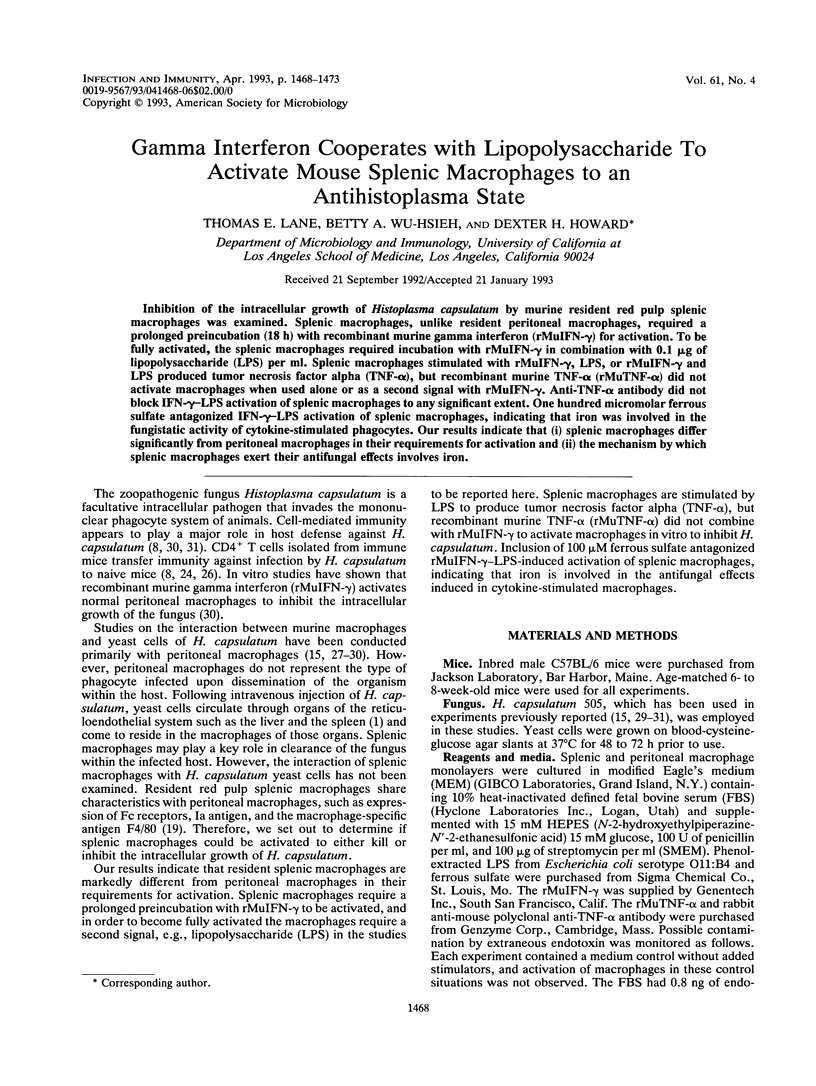
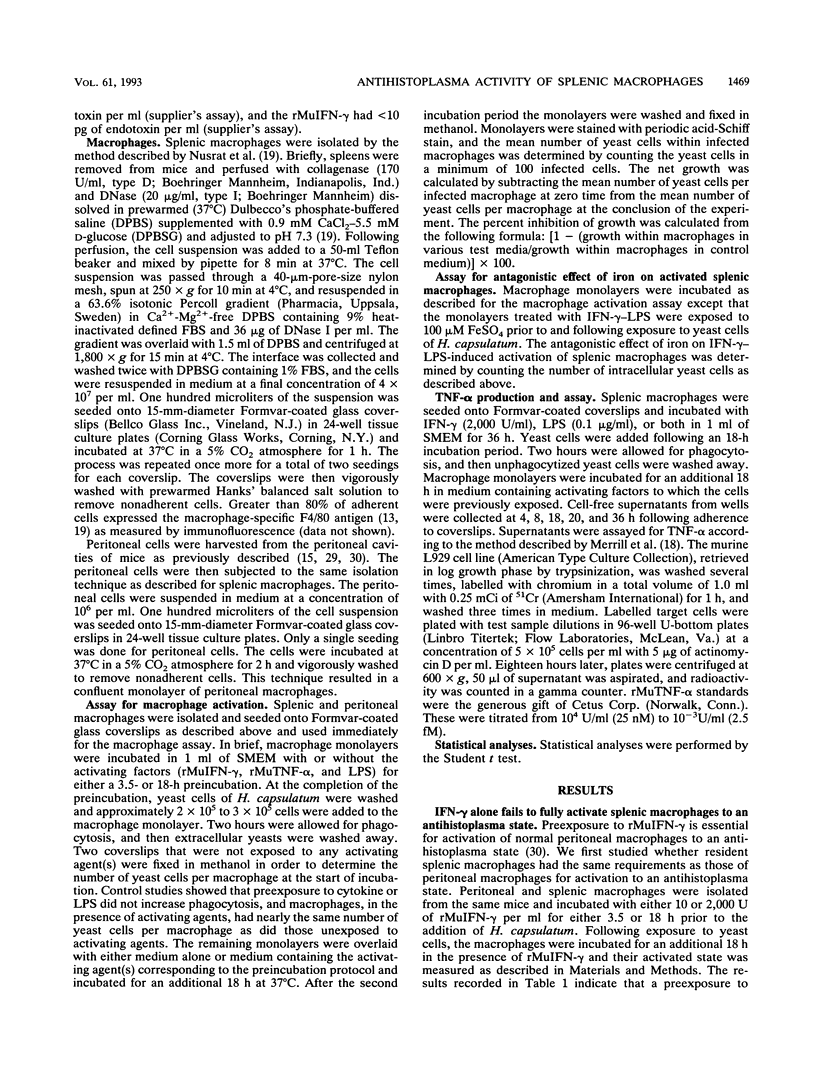
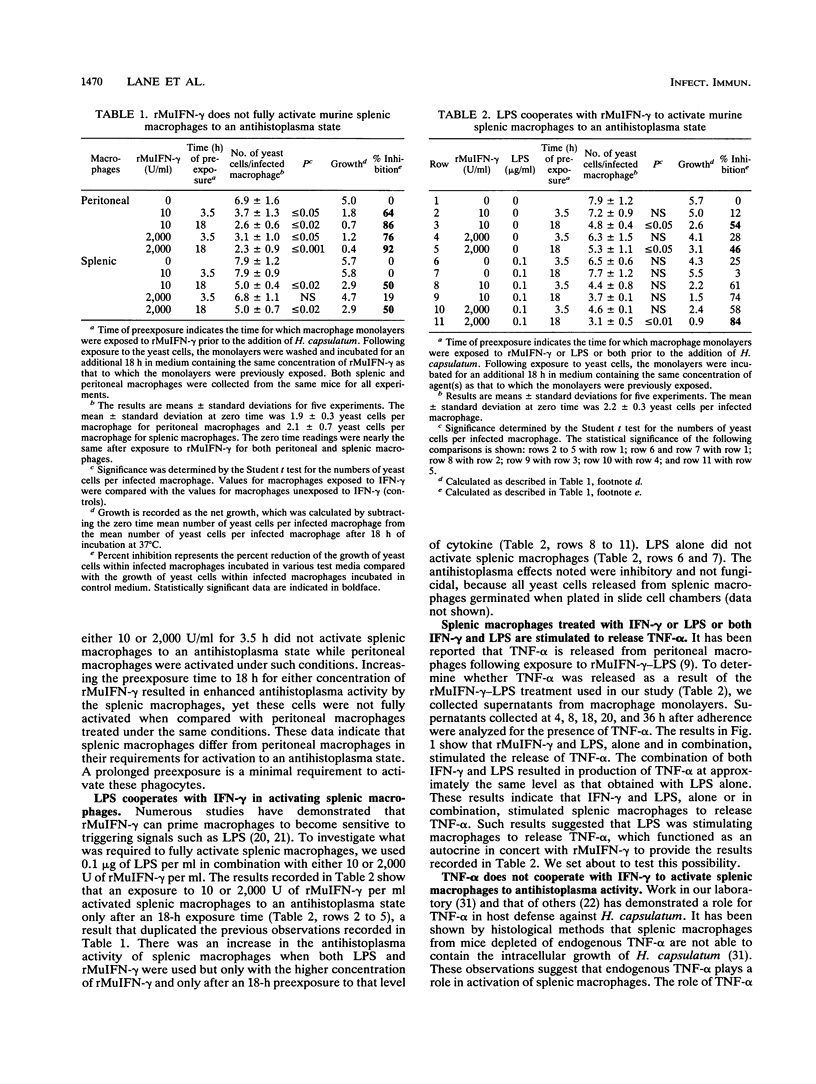
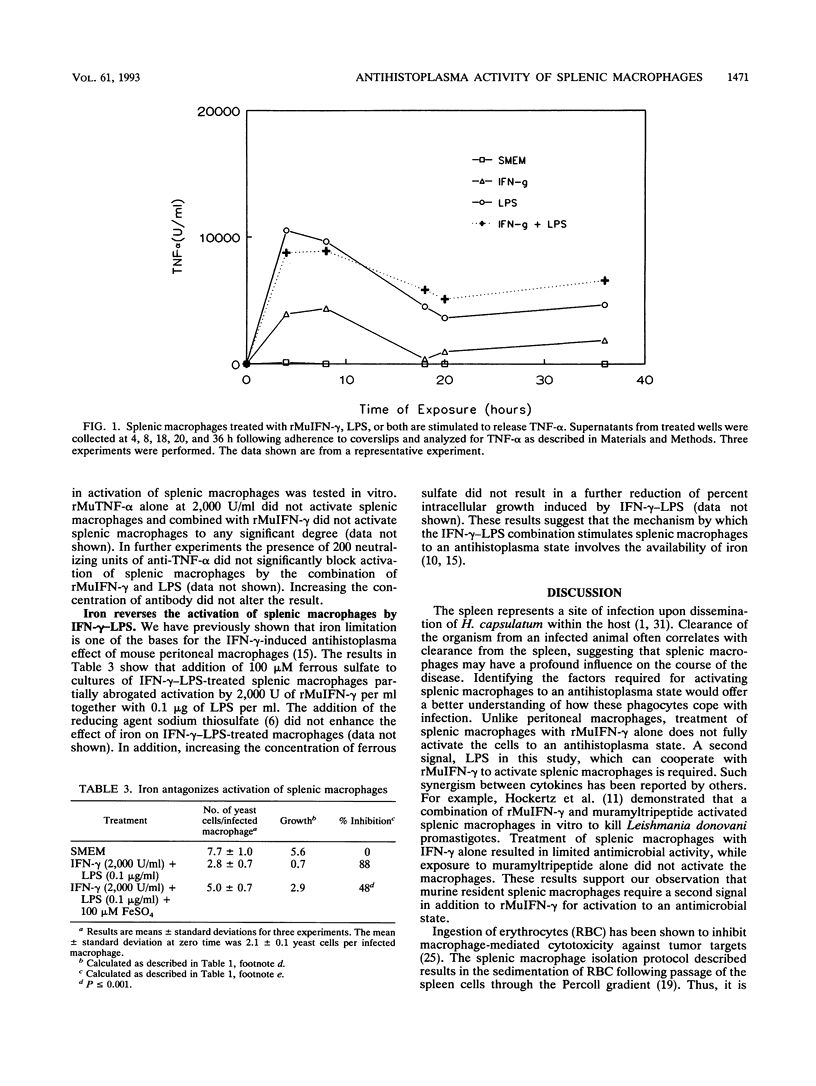
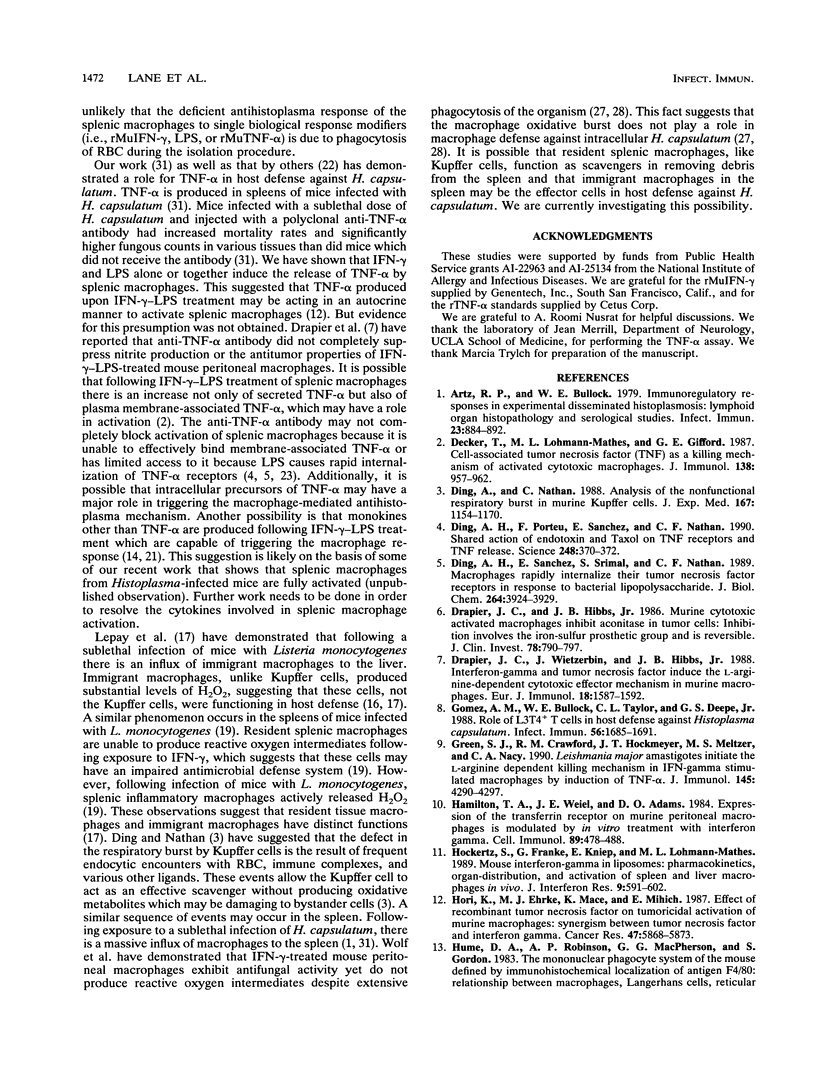
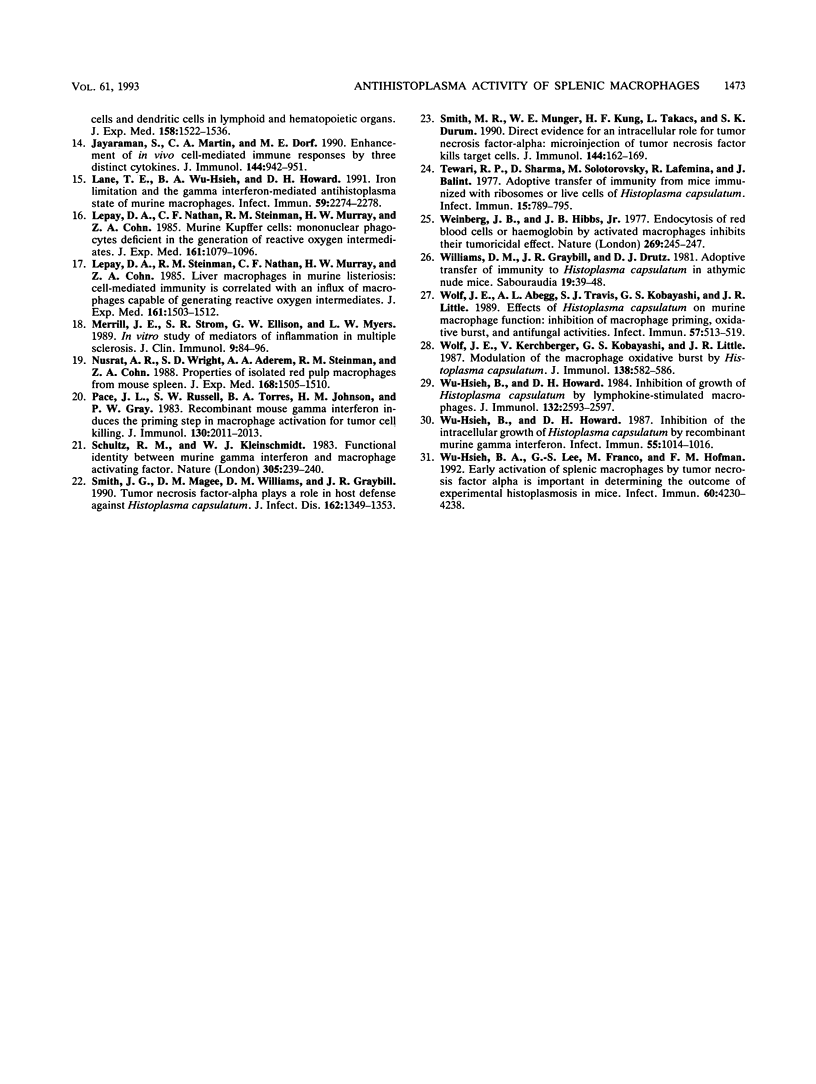
Selected References
These references are in PubMed. This may not be the complete list of references from this article.
- Artz R. P., Bullock W. E. Immunoregulatory responses in experimental disseminated histoplasmosis: lymphoid organ histopathology and serological studies. Infect Immun. 1979 Mar;23(3):884–892. doi: 10.1128/iai.23.3.884-892.1979. [DOI] [PMC free article] [PubMed] [Google Scholar]
- Decker T., Lohmann-Matthes M. L., Gifford G. E. Cell-associated tumor necrosis factor (TNF) as a killing mechanism of activated cytotoxic macrophages. J Immunol. 1987 Feb 1;138(3):957–962. [PubMed] [Google Scholar]
- Ding A. H., Porteu F., Sanchez E., Nathan C. F. Shared actions of endotoxin and taxol on TNF receptors and TNF release. Science. 1990 Apr 20;248(4953):370–372. doi: 10.1126/science.1970196. [DOI] [PubMed] [Google Scholar]
- Ding A. H., Sanchez E., Srimal S., Nathan C. F. Macrophages rapidly internalize their tumor necrosis factor receptors in response to bacterial lipopolysaccharide. J Biol Chem. 1989 Mar 5;264(7):3924–3929. [PubMed] [Google Scholar]
- Ding A., Nathan C. Analysis of the nonfunctional respiratory burst in murine Kupffer cells. J Exp Med. 1988 Mar 1;167(3):1154–1170. doi: 10.1084/jem.167.3.1154. [DOI] [PMC free article] [PubMed] [Google Scholar]
- Drapier J. C., Hibbs J. B., Jr Murine cytotoxic activated macrophages inhibit aconitase in tumor cells. Inhibition involves the iron-sulfur prosthetic group and is reversible. J Clin Invest. 1986 Sep;78(3):790–797. doi: 10.1172/JCI112642. [DOI] [PMC free article] [PubMed] [Google Scholar]
- Drapier J. C., Wietzerbin J., Hibbs J. B., Jr Interferon-gamma and tumor necrosis factor induce the L-arginine-dependent cytotoxic effector mechanism in murine macrophages. Eur J Immunol. 1988 Oct;18(10):1587–1592. doi: 10.1002/eji.1830181018. [DOI] [PubMed] [Google Scholar]
- Gomez A. M., Bullock W. E., Taylor C. L., Deepe G. S., Jr Role of L3T4+ T cells in host defense against Histoplasma capsulatum. Infect Immun. 1988 Jul;56(7):1685–1691. doi: 10.1128/iai.56.7.1685-1691.1988. [DOI] [PMC free article] [PubMed] [Google Scholar]
- Green S. J., Crawford R. M., Hockmeyer J. T., Meltzer M. S., Nacy C. A. Leishmania major amastigotes initiate the L-arginine-dependent killing mechanism in IFN-gamma-stimulated macrophages by induction of tumor necrosis factor-alpha. J Immunol. 1990 Dec 15;145(12):4290–4297. [PubMed] [Google Scholar]
- Hamilton T. A., Gray P. W., Adams D. O. Expression of the transferrin receptor on murine peritoneal macrophages is modulated by in vitro treatment with interferon gamma. Cell Immunol. 1984 Dec;89(2):478–488. doi: 10.1016/0008-8749(84)90348-4. [DOI] [PubMed] [Google Scholar]
- Hockertz S., Franke G., Kniep E., Lohmann-Matthes M. L. Mouse interferon-gamma in liposomes: pharmacokinetics, organ-distribution, and activation of spleen and liver macrophages in vivo. J Interferon Res. 1989 Oct;9(5):591–602. doi: 10.1089/jir.1989.9.591. [DOI] [PubMed] [Google Scholar]
- Hori K., Ehrke M. J., Mace K., Mihich E. Effect of recombinant tumor necrosis factor on tumoricidal activation of murine macrophages: synergism between tumor necrosis factor and gamma-interferon. Cancer Res. 1987 Nov 15;47(22):5868–5874. [PubMed] [Google Scholar]
- Jayaraman S., Martin C. A., Dorf M. E. Enhancement of in vivo cell-mediated immune responses by three distinct cytokines. J Immunol. 1990 Feb 1;144(3):942–951. [PubMed] [Google Scholar]
- Lane T. E., Wu-Hsieh B. A., Howard D. H. Iron limitation and the gamma interferon-mediated antihistoplasma state of murine macrophages. Infect Immun. 1991 Jul;59(7):2274–2278. doi: 10.1128/iai.59.7.2274-2278.1991. [DOI] [PMC free article] [PubMed] [Google Scholar]
- Lepay D. A., Nathan C. F., Steinman R. M., Murray H. W., Cohn Z. A. Murine Kupffer cells. Mononuclear phagocytes deficient in the generation of reactive oxygen intermediates. J Exp Med. 1985 May 1;161(5):1079–1096. doi: 10.1084/jem.161.5.1079. [DOI] [PMC free article] [PubMed] [Google Scholar]
- Lepay D. A., Steinman R. M., Nathan C. F., Murray H. W., Cohn Z. A. Liver macrophages in murine listeriosis. Cell-mediated immunity is correlated with an influx of macrophages capable of generating reactive oxygen intermediates. J Exp Med. 1985 Jun 1;161(6):1503–1512. doi: 10.1084/jem.161.6.1503. [DOI] [PMC free article] [PubMed] [Google Scholar]
- Merrill J. E., Strom S. R., Ellison G. W., Myers L. W. In vitro study of mediators of inflammation in multiple sclerosis. J Clin Immunol. 1989 Mar;9(2):84–96. doi: 10.1007/BF00916935. [DOI] [PubMed] [Google Scholar]
- Nusrat A. R., Wright S. D., Aderem A. A., Steinman R. M., Cohn Z. A. Properties of isolated red pulp macrophages from mouse spleen. J Exp Med. 1988 Oct 1;168(4):1505–1510. doi: 10.1084/jem.168.4.1505. [DOI] [PMC free article] [PubMed] [Google Scholar]
- Pace J. L., Russell S. W., Torres B. A., Johnson H. M., Gray P. W. Recombinant mouse gamma interferon induces the priming step in macrophage activation for tumor cell killing. J Immunol. 1983 May;130(5):2011–2013. [PubMed] [Google Scholar]
- Schultz R. M., Kleinschmidt W. J. Functional identity between murine gamma interferon and macrophage activating factor. Nature. 1983 Sep 15;305(5931):239–240. doi: 10.1038/305239a0. [DOI] [PubMed] [Google Scholar]
- Smith J. G., Magee D. M., Williams D. M., Graybill J. R. Tumor necrosis factor-alpha plays a role in host defense against Histoplasma capsulatum. J Infect Dis. 1990 Dec;162(6):1349–1353. doi: 10.1093/infdis/162.6.1349. [DOI] [PubMed] [Google Scholar]
- Smith M. R., Munger W. E., Kung H. F., Takacs L., Durum S. K. Direct evidence for an intracellular role for tumor necrosis factor-alpha 1. Microinjection of tumor necrosis factor kills target cells. J Immunol. 1990 Jan 1;144(1):162–169. [PubMed] [Google Scholar]
- Tewari R. P., Sharma D., Solotorovsky M., Lafemina R., Balint J. Adoptive transfer of immunity from mice immunized with ribosomes or live yeast cells of Histoplasma capsulatum. Infect Immun. 1977 Mar;15(3):789–795. doi: 10.1128/iai.15.3.789-795.1977. [DOI] [PMC free article] [PubMed] [Google Scholar]
- Weinberg J. B., Hibbs J. B., Jr Endocytosis of red blood cells or haemoglobin by activated macrophages inhibits their tumoricidal effect. Nature. 1977 Sep 15;269(5625):245–247. doi: 10.1038/269245a0. [DOI] [PubMed] [Google Scholar]
- Williams D. M., Graybill J. R., Drutz D. J. Adoptive transfer of immunity to Histoplasma capsulatum in athymic nude mice. Sabouraudia. 1981 Mar;19(1):39–48. [PubMed] [Google Scholar]
- Wolf J. E., Abegg A. L., Travis S. J., Kobayashi G. S., Little J. R. Effects of Histoplasma capsulatum on murine macrophage functions: inhibition of macrophage priming, oxidative burst, and antifungal activities. Infect Immun. 1989 Feb;57(2):513–519. doi: 10.1128/iai.57.2.513-519.1989. [DOI] [PMC free article] [PubMed] [Google Scholar]
- Wolf J. E., Kerchberger V., Kobayashi G. S., Little J. R. Modulation of the macrophage oxidative burst by Histoplasma capsulatum. J Immunol. 1987 Jan 15;138(2):582–586. [PubMed] [Google Scholar]
- Wu-Hsieh B. A., Howard D. H. Inhibition of the intracellular growth of Histoplasma capsulatum by recombinant murine gamma interferon. Infect Immun. 1987 Apr;55(4):1014–1016. doi: 10.1128/iai.55.4.1014-1016.1987. [DOI] [PMC free article] [PubMed] [Google Scholar]
- Wu-Hsieh B. A., Lee G. S., Franco M., Hofman F. M. Early activation of splenic macrophages by tumor necrosis factor alpha is important in determining the outcome of experimental histoplasmosis in mice. Infect Immun. 1992 Oct;60(10):4230–4238. doi: 10.1128/iai.60.10.4230-4238.1992. [DOI] [PMC free article] [PubMed] [Google Scholar]
- Wu-Hsieh B., Howard D. H. Inhibition of growth of Histoplasma capsulatum by lymphokine-stimulated macrophages. J Immunol. 1984 May;132(5):2593–2597. [PubMed] [Google Scholar]


